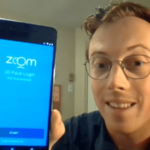
FaceTec is bringing attention to a biometric security issue that is too often overlooked – liveness detection. The face authentication leader has published a new white paper, entitled “Liveness Detection: Biometric Frontline or Final Frontier?“, that lays out the importance of getting certified liveness detection technology right in today’s current digital landscape.
Download FaceTec’s latest educational white paper:
“Liveness Detection: Biometric Frontline or Final Frontier?”
FaceTec should know. With its ZoOm 3D Face Authentication system, FaceTec became the first company to attain Level-1 certification in the rigorous iBeta Presentation Attack Detection evaluation last summer. And in February of this year, FaceTec announced that it had become the first to reach Level-2 certification.
That’s a big deal. iBeta is the only NVLAP-accredited lab offering evaluations against the ISO 30107 standard. And, the only biometric to attain Level-2 certification, FaceTec resisted thousands of spoofing attempts with a 100 percent perfect anti-spoofing score.
Laying out the kind of effort that went into establishing such spoof-resistant technology, FaceTec CEO Kevin Alan Tussy asserts in the white paper that his team has developed or bought tens of thousands of physical spoof artifacts like 3D printed faces and masks; “and we’ve even tested our algorithms at Madame Tussauds Wax Museum,” he added. “This is the level of commitment that it takes to achieve Level 1&2 certifications.”
And with FaceTec’s technology now being embraced by other face-based authentication specialists like Jumio, there’s more reason than ever heed the firm’s expertise in this area.
“Liveness Detection: Biometric Frontline or Final Frontier?” is the second in a series of white papers from FaceTec. The first document, “Standardized Anti-Spoof Testing – Cutting through the hype and finding integrity in biometrics“, is an educational guide to third-party biometrics testing, and calls for greater transparency and accountability in the biometric authentication industry.
–
March 11, 2019 – by Alex Perala


![Standardized Testing for Biometrics: Cutting Through the Hype and Finding Integrity in Digital Identity [FaceTec White Paper]](https://idtechwire.com/wp-content/uploads/face-auth-hero-1-150x150.jpg)




Follow Us